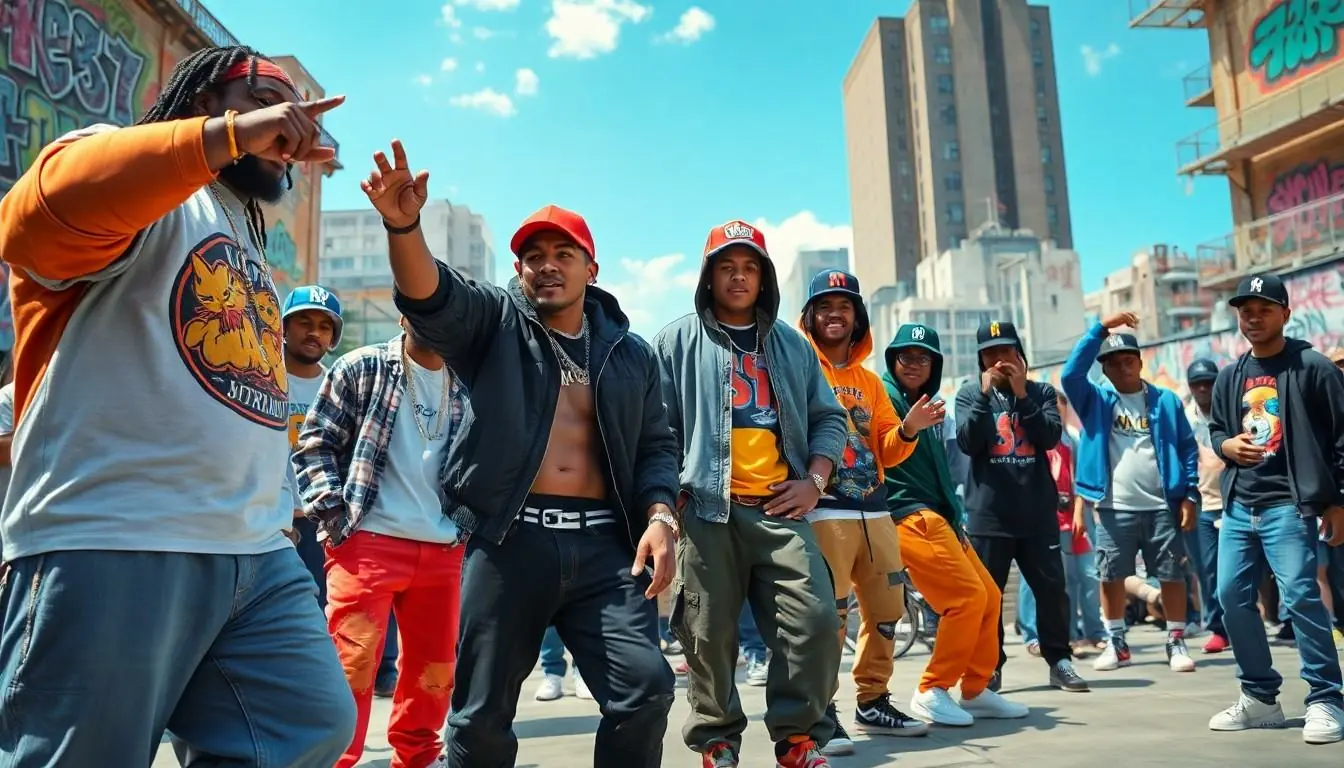The golden age of hip hop wasn’t just a moment; it was a cultural explosion that shook the music world to its core. Picture this: block parties, graffiti art, and lyrical battles that could elevate a neighborhood’s street cred faster than a new pair of Air Jordans. From the late ’80s to the mid-’90s, hip hop transformed from underground grooves to mainstream dominance, and it did so with style, wit, and a whole lot of swagger.
This era birthed legends like Tupac, Biggie, and Nas, whose verses still echo through the streets today. It was a time when storytelling reigned supreme, and every beat had a message that resonated with a generation. Dive into this nostalgic journey and discover how the golden age of hip hop laid the groundwork for today’s artists while reminding us that the best rhymes often come with a side of humor and heart.
Table of Contents
ToggleOrigins Of The Golden Age Of Hip Hop
The golden age of hip hop emerged as a response to socio-political conditions and cultural shifts. This era laid the groundwork for the genre’s evolution and widespread acceptance.
Key Influences
The late ’70s and early ’80s set the stage for hip hop’s rise. Breakdancing gained popularity at block parties, showcasing creativity and athleticism. DJs like Kool Herc introduced innovative mixing techniques that shaped the soundscape. The socio-economic challenges faced by urban communities inspired artists to express their realities through music. Additionally, the emergence of graffiti as an art form complemented hip hop culture. Influenced by funk, disco, and soul, artists blended these genres, creating a rich musical tapestry.
Pioneering Artists
Pioneering artists significantly shaped the golden age of hip hop. Grandmaster Flash and The Furious Five released “The Message,” defining socially conscious lyrics. Run-D.M.C. bridged the gap between rock and rap, expanding the genre’s appeal. Eric B. and Rakim revolutionized lyricism with complex wordplay and intricate rhythms. Groups like A Tribe Called Quest and De La Soul introduced jazz influences, enriching the sound. Female artists like Queen Latifah and MC Lyte emerged, adding diversity to the narrative. Each contributed unique styles, further solidifying hip hop’s dynamic identity.
Defining Characteristics

The golden age of hip hop showcases distinctive features that define its legacy. Remarkable lyrical depth and innovative production techniques emerged during this period.
Lyrical Complexity
Lyrical complexity plays a significant role in the golden age, with artists delivering intricate storytelling and thought-provoking themes. While Tupac’s narratives explored societal struggles, Biggie emphasized street life and personal experiences. Nas introduced sophisticated wordplay, challenging listeners to engage deeply with his lyrics. Diverse subjects ranged from social justice to personal introspection. Artists crafted rhymes that blended humor with poignant commentary, enriching the genre’s appeal. This era’s lyricists skillfully used metaphors, similes, and alliteration, enhancing the emotional weight of their messages. Collectively, the complexity of their lyrics fostered a deeper connection with audiences.
Production Techniques
Production techniques during the golden age transformed hip hop’s soundscape. DJs and producers utilized sampling from funk, soul, and jazz, creating rich musical backdrops. Innovators like DJ Premier pioneered techniques such as chopping and looping, enhancing rhythmic texture. Boom-bap beats became the signature sound, characterized by hard-hitting drums and basslines. When artists collaborated with skilled producers, they pushed creative boundaries, resulting in timeless tracks. Sonic experimentation included layering sounds and melodies, inviting diversity into the genre. These techniques established a foundation for contemporary production while influencing future generations of artists.
Iconic Albums And Songs
The golden age of hip hop produced landmark albums and unforgettable tracks that defined the genre.
Landmark Releases
Albums like “Illmatic” by Nas, released in 1994, set a new standard for lyrical excellence, showcasing storytelling and intricate wordplay. “Ready to Die,” Biggie’s debut in 1994, immersed listeners in the harsh realities of street life through vivid narratives. Tupac’s “All Eyez on Me,” a double album released in 1996, captured the raw emotional intensity and charisma of the artist. Each release contributed to a collective movement, solidifying hip hop’s cultural significance during this period. Notable mentions also include A Tribe Called Quest’s “The Low End Theory,” which introduced jazz influences and complex rhythms, and De La Soul’s “3 Feet High and Rising,” celebrating creativity and positivity in hip hop.
Notable Collaborations
Collaborations during this era delivered powerful combinations of talent. The partnership between Eric B. and Rakim produced tracks that masterfully blended innovative production with impactful lyrics. “Juicy,” a cornerstone of Biggie’s catalog, featured contributions from Puff Daddy and showcased the interplay between commercial appeal and authenticity. Other memorable collaborations include “California Love” by Tupac and Dr. Dre, which celebrated West Coast culture. Additionally, the work of Gang Starr, notably their track “Mass Appeal,” highlighted the synergy between assertive beats and thoughtful lyrics. Each collaboration enhanced the genre’s richness, leaving a lasting impact on music history.
Cultural Impact
The golden age of hip hop significantly shaped cultural dynamics from the late ’80s to the mid-’90s. It fostered a sense of identity and connection among urban communities.
Influence On Society
Hip hop’s influence permeated various facets of society, addressing issues like poverty, racism, and violence. Artists like Tupac and Nas highlighted social injustices through their lyrics, sparking dialogues and raising awareness. The powerful narratives provided a voice for marginalized communities, facilitating discussions that often went unnoticed in mainstream media. Its popularity among youth also inspired movements that promoted education and social change, encouraging activism through art. Events like hip hop festivals united diverse groups, demonstrating the genre’s ability to bridge cultural gaps.
Contributions To Other Genres
In addition to shaping its own sound, hip hop significantly impacted other music genres. Funk, jazz, and soul artists incorporated sampling techniques into their productions after nearly every hip hop hit introduced experimental sounds. Rock and pop musicians began collaborating with hip hop artists, broadening their appeal and creating innovative crossovers. Groups like the Beastie Boys and collaborations such as Jay-Z and Linkin Park illustrated this fusion, expanding hip hop’s reach. Even today’s popular music continues to exhibit hip hop influences, exemplifying the genre’s lasting legacy across musical landscapes.
The End Of An Era
The end of the golden age of hip hop marked a significant shift in the genre’s direction. Changes in the music industry played a crucial role. The rise of commercialism shifted focus from artistic expression to marketability. Major record labels increasingly prioritized profitability over authenticity. As a result, artists found themselves under pressure to conform to mainstream expectations, altering their musical styles.
Technological advancements also altered the landscape. The advent of digital music and home studios democratized production. Artists began producing music independently, leading to a surge in diverse voices. Despite the challenges, these shifts paved the way for new creative opportunities.
Factors Leading To Change
Several factors contributed to the decline of the golden age. The shift from local to global markets reshaped artist visibility. Fans began favoring catchy hooks and radio-friendly tracks over lyrical complexity. Hip hop also faced increased competition from other genres, such as pop and R&B. Trends in mainstream culture often sidelined deep storytelling for polished performances and viral moments.
Moreover, the introduction of new technologies affected the production process. As studios became more accessible, sonic experimentation decreased in favor of formulaic beats. While some artists thrived in this new landscape, many established voices struggled to adapt. The nostalgic essence of the golden age faced challenges against fast-paced industry demands.
Legacy And Evolution
The legacy of the golden age remains influential in contemporary hip hop. Artists continue to draw inspiration from the lyrical depth and storytelling established during this era. Iconic albums serve as benchmarks for aspiring musicians, emphasizing the importance of authenticity. Artists like Kendrick Lamar and J. Cole honor the traditions of their predecessors while pushing boundaries.
Cultural impacts extended beyond music, influencing fashion and social movements. The genre’s ability to address societal issues persists within modern lyrics. Hip hop even paved the way for new sub-genres, allowing for diverse sounds to emerge. This evolution showcases how the foundations laid during the golden age still resonate today. The essence of hip hop remains, evolving while honoring its rich heritage.
The golden age of hip hop stands as a pivotal chapter in music history. Its rich tapestry of creativity and cultural significance continues to inspire artists and fans alike. The era’s groundbreaking lyrical depth and innovative production techniques set standards that resonate in today’s hip hop landscape.
As contemporary artists navigate the complexities of modern society, they often look back to the powerful narratives and social consciousness that defined this period. The influence of this golden age transcends music, fostering a sense of community and activism that remains relevant.
In celebrating its legacy, hip hop not only honors its past but also embraces its future, ensuring that the spirit of this vibrant era lives on in every beat and rhyme.



